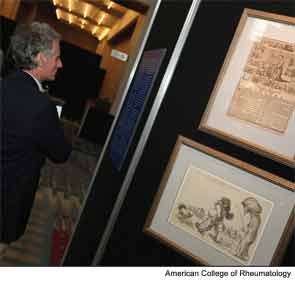This year, a highly insightful commentary on the history of these lithographs accompanied the magnificent display in Washington, D.C. Written by Melvin C. Britton, MD, a distinguished master member of the ACR from Atherton, Calif., it describes the transition of gout from being regarded as an infliction that was unique to members of a bloated aristocracy to the spread of its pain and misery to the masses. This viewpoint was echoed by this witty remark in Punch magazine: “It is ridiculous that a man should be barred from enjoying gout because he went to the wrong school.”4 As Dr. Britton points out, these lithographs provided viewers with a biting commentary on the political currents of the era, spanning the late 18th century up to the early Victorian years.6 They reflected the intense political debates within and around the British Empire. The world had been turned upside down by the American Revolution. In France, the turmoil of their revolution, which spawned the countless beheadings of members of the monarchy and aristocracy, was followed by Napoleon’s megalomania. It must have been refreshing for the citizenry to poke fun at the ruling class without the risk of inflicting their wrath.

An American Link: Gout
The effect of gout on the British ruling class may have also influenced American political history.4 The British statesman and leader William Pitt the Elder suffered from gout. During one of Pitt’s gout-related absences from Parliament, the Stamp Act (1765) was passed, which forced the unwilling colonists to pay a tax to defray the costs of defending the colonies against French attack. Following his recovering from gout, Pitt succeeded in getting the act repealed with the famous words, “The Americans are the sons, not the bastards, of England. As subjects, they are entitled to the right of common representation and cannot be bound to pay taxes without their consent.” Unfortunately, during another of Pitt’s absences due to an episode of gout, Lord Townshend persuaded Parliament to levy a heavy duty on colonial imports of tea to raise the necessary revenues. This precipitated the Boston Tea Party (1773), and we all know the rest of this story! By January 1788, five of the nine required states had ratified the Constitution. One notable holdout was Massachusetts, whose governor, revolutionary leader John Hancock, was unable to make up his mind on the Constitution and took to his bed with what was seen at the time as a convenient case of gout. Later, after being tempted by the Federalists with the vice presidency, Hancock experienced a miraculous cure and delivered his critical block of votes.


